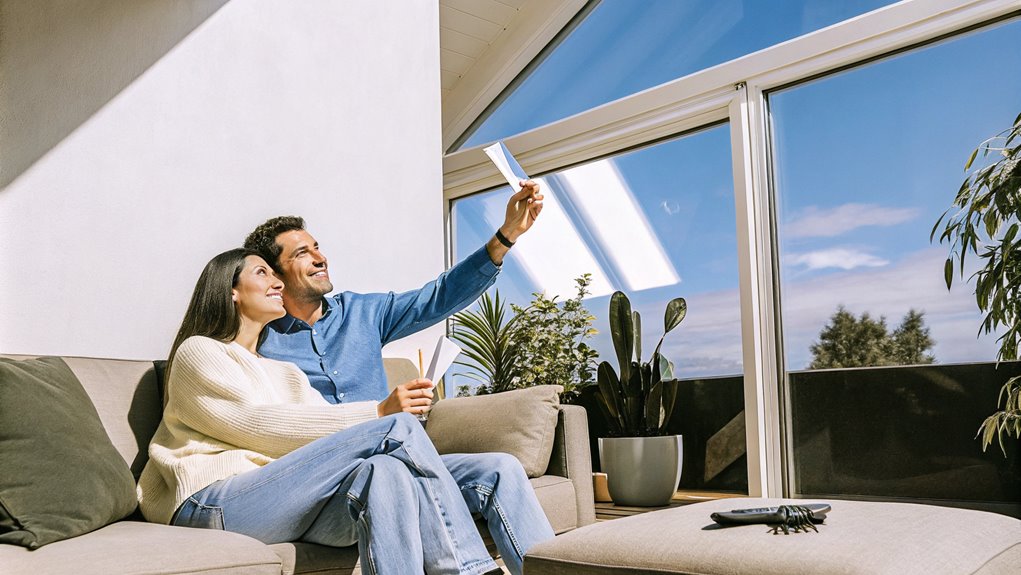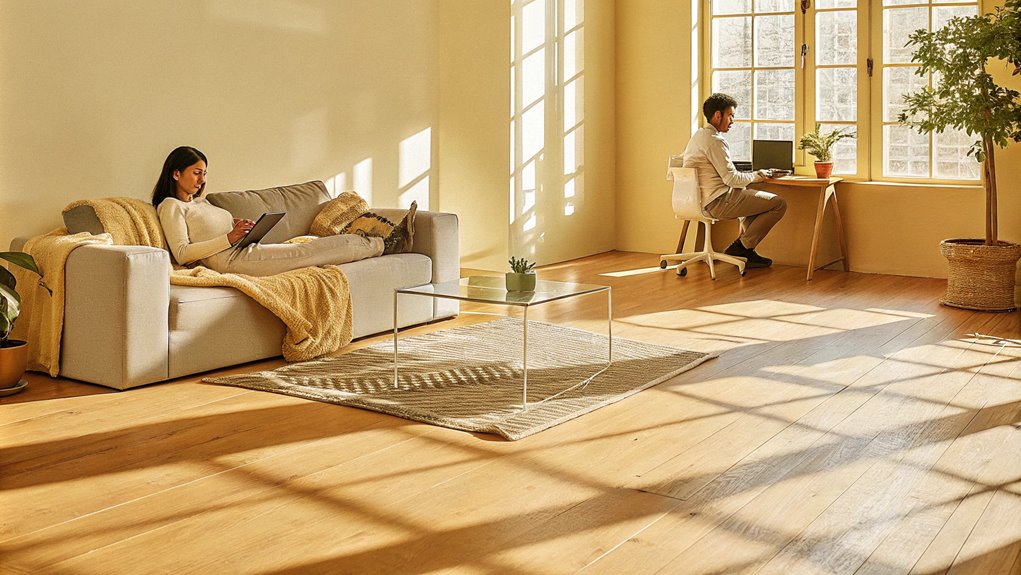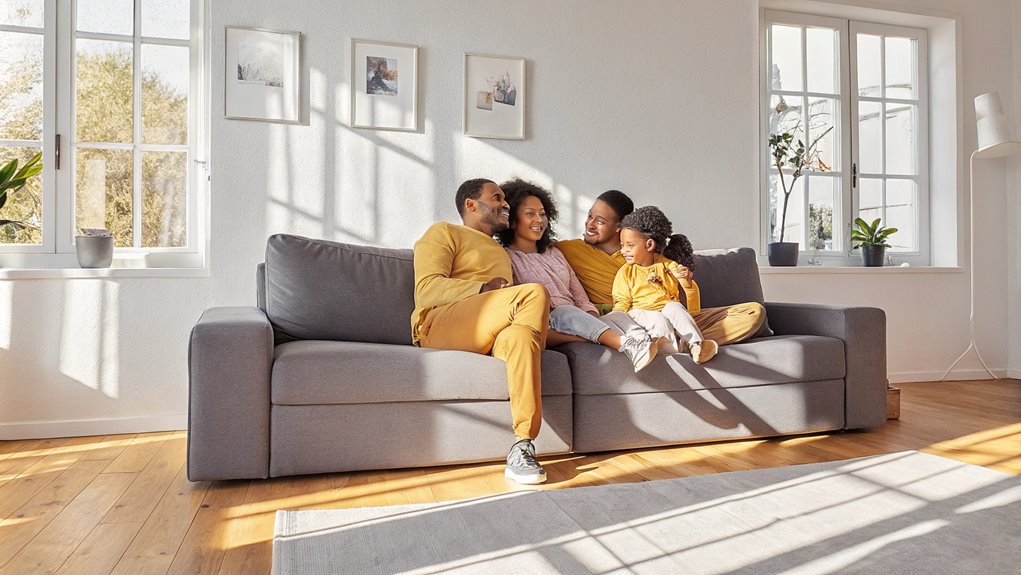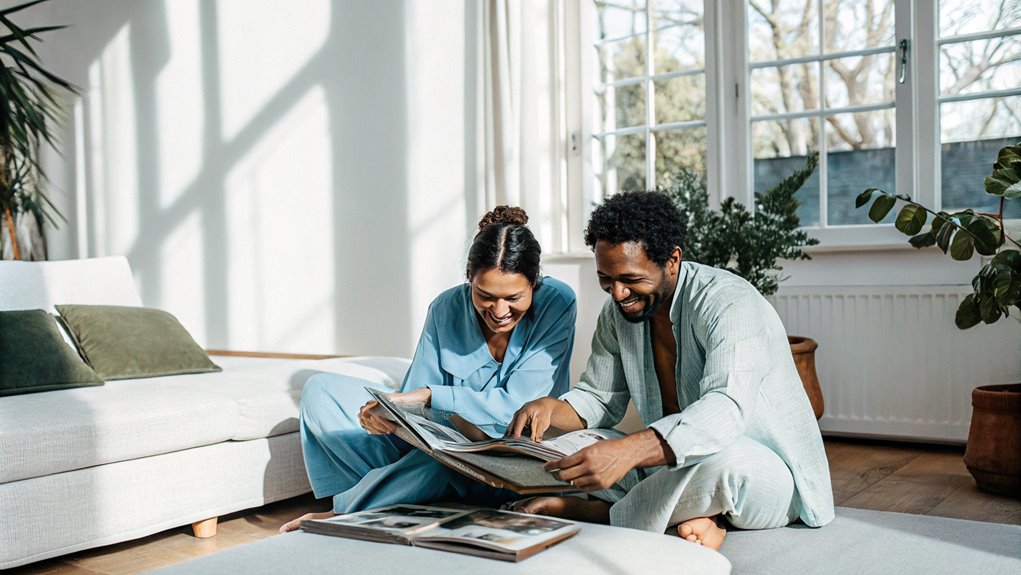Your home is more than just walls and a roof – it's where you feel safe and happy. When you feel good at home, your body helps you stay calm and worry less. Just like a cozy blanket makes you feel warm, a nice home makes your heart feel warm too. Make special spots for fun, rest, and family time. Clean up mess, use soft lights, and create quiet places to sit. These small things help you feel better every day. When you know how to make your home feel good, you and your family will be happier.
Ready to start building equity in your own Michigan home? Get your personalized home loan quote today.
The Science Behind Home Emotions

Your home is like a friend who can make you feel happy or sad. When you walk into a room that feels cozy and safe, your brain makes happy chemicals. These chemicals help you feel calm and at peace.
But when your home is messy, your brain makes stress chemicals that can make you feel bad.
Light and colors in your home matter too. Bright, warm lights can make you feel good, like when you see an old friend. Nice colors can make you smile.
When you keep your home neat and pick colors you love, you help your brain make more happy feelings.
Think of your home as a happy place. When you make it look and feel nice, you help yourself feel better. It's like giving yourself a big hug every time you walk through the door.
Michigan residents, unlock the door to your new home. Request your home loan quote from Treeside Financial today.
Creating Safe Emotional Spaces
Your home should have special spots where you feel safe and calm. Think of these spots as your own quiet places where you can be yourself and feel better when you're stressed.
These special spots need things that make you feel good. You can set them up in different ways:
| Space Type | Purpose | What You Need |
|---|---|---|
| Quiet Corner | A place to think or read | Soft lights, comfy chair |
| Art Space | A place to make things | Paint, paper, desk |
| Cozy Spot | A place to let feelings out | Private area, soft pillows |
| Green Space | A place to feel peaceful | Plants, sun |
| Safe Space | A place to feel secure | Warm blankets, your favorite things |
Look at each room in your home. Does the light make you feel good? Is the chair comfy? Take away things that make you feel bad. Add things that make you feel happy and safe. When you fix up your spaces this way, you'll feel better every day.
Boundaries Within Living Spaces

Your home should feel safe and happy for everyone. Setting clear rules helps family members respect each other's space and needs.
Think of your home like a cozy nest. Each bird needs its own spot to rest. Your family members need their own spots too.
Try these simple rules:
- Give each person a quiet space to be alone
- Pick times when the house should be quiet
- Always knock on doors before going in
- Make clear rules about who cleans up shared spaces
When everyone knows and follows these rules, your home feels better. Your kids will know what to expect. You'll all feel more at peace.
These rules don't keep people apart. They help your family grow closer. When people respect each other's space, they get along better. This makes your home a place where everyone can be themselves.
You might be closer to buying your home than you think
Take our 2-minute home buyer readiness quiz to see how prepared you really are – no credit check required.

Healing Through Home Design
Your home can make you feel better. Think of it like a big hug.
Pick soft colors like light blue and green to help you feel calm. Big open rooms can make you feel free. Small cozy rooms can make you feel safe.
You can turn your home into a place that helps you feel good. Pick colors you love. Make spaces that help you feel happy and at peace.
Colors Impact Mental Health
Colors in your home can make you feel better or worse. Let's pick the right ones for each room!
Colors do more than make rooms look nice – they change how we feel. Think about what you want to feel when you walk into a room.
Blue makes people feel calm and less worried. Put blue in your bedroom or where you work.
Yellow is like sunshine – it makes people happy. Use it in your kitchen or where friends gather.
Green feels like being outside in nature. It works great in living rooms or where you read.
White makes rooms feel big and clean. But don't use too much, or your room might feel cold.
Pick colors that match how you want to feel in each room. Soon you'll notice how much better your home makes you feel.
Space Shapes Your Emotions
Your home's shape and layout change how you feel. When your home is messy, you might feel worried and stressed. But when rooms are open and clear, you feel free and happy.
The height of your room changes how you think. Tall rooms help you dream big. Low rooms help you focus on small things.
Where you put your chairs and tables is important too. Make spots for talking with friends. Add quiet places to rest.
Look at how you walk in your rooms. If you bump into chairs or feel stuck, move things around. Even small fixes, like moving a couch or clearing a path, can make you feel better at home.
Family Dynamics at Home

Living together as a family makes your home feel special. The way family members talk and act with each other sets the mood in your home. When everyone gets along, home feels warm and happy. When there's fighting, home feels tense and hard.
To make home feel better:
- Make spots where the family can be together, and spots where people can be alone
- Listen when others talk and let everyone share their thoughts
- Do the same things at the same times each day
- Plan fun stuff to do together, but let people choose what they like
When you help your family get along better, everyone feels more loved. Being kind to each other makes your home a nice place to be. The more you work at it, the closer your family will grow.
Mindful Room Arrangements
Your home's rooms affect how you and your family feel every day. Smart room setup can help everyone feel good and close to each other.
Rooms can do different things for your feelings:
- Places to gather make it easy to talk and be together
- Quiet spots help you think and rest
- Entry areas help you relax when coming home
- Fun spaces let you share good times as a family
Think about what makes your family feel good when you set up rooms. Put chairs so people can see each other's faces while they talk.
Make some soft, cozy spots for quiet time. Keep paths clear so everyone can walk around easily.
When you plan your rooms this way, there will be less fighting and more happy times. Everyone will feel safe and loved in your home.
Energy Flow Between Spaces

Moving between rooms should feel easy, like a dance. When one room leads nicely to the next, you'll feel at home everywhere. Think of your house like a river – the energy should flow smooth and free.
Make paths clear:
- Put your chairs and tables where they won't block the way
- Use the same kind of floor from room to room
- Keep colors in nearby rooms friendly with each other
- Don't let stuff pile up in halls or doorways
How your home flows matters. It helps you and your family move around better.
When you can see and walk from room to room with no trouble, your home feels more peaceful. This makes daily life better.
Balancing Privacy and Connection
Your home needs both spaces to be together and spaces to be alone.
Like a cozy living room where you can talk with family. And a quiet bedroom where you can read or rest by yourself.
You can split up these spaces in simple ways. Move the couch to make a reading spot. Use a lamp to make one area bright for games and another soft for quiet time. Put up a screen to block off a peaceful corner.
Rooms can do more than one thing. Your desk area can be for work during the day. At night, it can be where you sit quietly and think.
The kitchen table is for meals with family, but it can also be where kids do homework alone.
We all need time with others and time by ourselves. When you fix up your home, make sure you have both. This helps everyone feel happy and get along better.
Decluttering Emotional Baggage

When we hold onto old feelings, it's like keeping too many things in our house.
Just like cleaning our room helps us feel better, letting go of old hurt feelings helps our hearts feel lighter.
Getting rid of stuff we don't need anymore makes space for new, happy times.
When we stop holding onto things from the past, our minds feel clearer and our hearts feel free.
Break Patterns of Hoarding
We all feel scared to let go of things we love. But keeping too much stuff can make us feel stuck. Letting go helps us grow and feel better.
Start with things that make you feel sad when you see them. These items often hurt us the most.
Set a timer for 15 minutes each day. Look at one spot in your home. This way, you won't feel too tired.
Put things you can't decide about in a box. Wait 30 days. Then look at them again.
Take pictures of special items before you give them away. This helps you keep the happy times in your heart without filling up your home.
Clear Space, Clear Mind
Your home is like your mind – keeping it clean helps you feel better inside.
Look around your home. Do some spots make you feel stressed? These are good places to start cleaning up.
Take it slow. Pick up each thing and think: "Do I need this now?" It's OK to let go of old stuff that makes you sad.
When you throw away things you don't need, you feel lighter.
Give special spots to things you love.
When your home shows what matters to you now, you feel more like yourself. Keep only the things that help you live better today.
Building Trust Through Environment
Our homes help us build trust with our loved ones. When your home feels safe and warm, your family grows closer. Making a home that builds trust is more than just keeping it clean – it's about making spaces where people feel safe to open up.
Try these simple things:
- Make cozy spots where family can talk freely
- Give each person their own quiet space
- Keep daily habits that stay the same
- Make places where family can do fun things together
When you make your home a place of trust, you help your family feel good inside.
Put chairs and sofas facing each other. Use warm lights to help everyone relax. Make some spots where phones and screens aren't allowed, so people can really talk to each other.
Routines That Foster Connection

Our families grow closer when we take small steps to connect each day. A morning hello and quick chat helps us start the day with love. When Mom asks "How did you sleep?" or Dad shares a joke, we feel cared for.
Eating meals as a family lets us talk about our day. Even if we only eat dinner together twice a week, that time matters. At the table, we can tell stories, share what made us happy or sad, and celebrate good things that happened.
These simple habits bring us closer and make our family bond strong.
Daily Check-In Rituals
Families grow closer when we take time to really see and hear each other every day. These small moments help us share our true feelings and show we care.
We can make simple check-ins part of our daily life:
- Talk at breakfast about what we hope to do that day
- Share the best and worst parts of our day at dinner
- Spend quiet time with each kid before bed
- Make time to talk with our partner about life
These moments can be short and easy. The key is to do them every day and listen with your whole heart.
When we make time for each other, everyone in the family feels loved and safe.
All it takes is a few minutes to ask "How are you?" and really listen to the answer.
Over time, these little chats help build a happy, close family where everyone knows they matter.
Shared Mealtime Moments
Eating together makes families closer. When we sit at the table, we do more than eat – we learn to trust each other and share our feelings.
Try to eat as a family at least four times each week, even when you're busy.
Keep phones and TV off during meals. This helps everyone talk better. Ask your family about their day and listen when they speak. Kids will tell you more when they feel you care about what they say.
Start fun meal habits, like sharing the best part of your day or saying what makes you happy. When families eat together often, they grow closer and feel better.
Conflict Resolution at Home
When people live together, they sometimes disagree. This is normal in every home. These moments can make your family stronger if you handle them well.
Take a break when you feel angry. Let yourself cool down before you talk about what's wrong.
When others speak, be quiet and really hear them. Show them you care about their feelings. Talk about what's wrong, not what's wrong with the person.
Make rules that help everyone get along. Think about what each person needs.
Fixing problems isn't about being right. It's about getting closer as a family. When you're kind and patient, your family will trust you more.
They'll feel safe to share their worries. Then you can work out tough times together.
Home as Emotional Anchor

Your home is a special place where you can be you. When life gets hard, coming home feels like a big hug. This is where you can feel your feelings, rest, and find peace.
Think of your home like a friend who helps you feel better:
| Room | What it Gives You | How to Make it Work |
|---|---|---|
| Bedroom | Rest & Quiet | Soft lights, no phones |
| Living Room | Time with Others | Comfy seats, room to talk |
| Kitchen | Good Food | Clean space, neat tools |
| Bathroom | Me Time | Calm colors, no clutter |
| Your Spot | Quiet Thinking | Peaceful corner, things you love |
Make each room help you feel good. Put things where they make sense. When your home feels right, you feel right too.
Nurturing Growth Through Space
Make a special place in your home just for you.
It can be a quiet corner with a comfy chair to read. Or a peaceful spot with pillows to sit and be still. Maybe a table where you can draw and make things. Pick a space where no one will bother you.
Add soft things you like to touch. Use colors that make you feel calm. Put up pictures that make you happy.
This will be your own safe spot. You can go there when you need to think or feel better.
When you have your own space, it helps you grow and stay strong inside.
It's like having a friend who's always there for you.
Cultivating Personal Safe Zones
Safe spaces in your home help you and your loved ones feel better.
Think of them as special spots where you can take deep breaths and feel calm. These spots make everyone in your home feel safe and happy.
You can make these spots in many ways:
- Put soft pillows and a lamp in a quiet corner to read
- Make a place to draw and paint
- Pick a quiet spot to sit and think
- Set up a place to listen to music or sing
Let each person have their own special spot. This shows you care about what they need.
These spots aren't meant to keep people apart. They help bring your family closer by giving everyone room to be themselves.
Design For Mental Wellness
Your home can help you feel better every day. Let the sun shine in through your windows – it helps you sleep well and stay happy.
Pick wall colors that make you feel calm and peaceful.
Set up your rooms in ways that make you feel good. Put your chairs and tables where you can walk around them easily.
Make special spots just for you – maybe a quiet corner to sit and think, or a cozy place to read. Add some plants and wooden things too. They help you worry less and think better.
Your home should be more than a place for your stuff. It should be a safe space where you can relax and feel good.
Room To Breathe Free
Your home feels better when you give yourself space to move. Just like your body needs room to stretch, your mind needs room to rest and think.
You can make your home more open by:
- Making a quiet spot with no mess
- Putting space between your chairs and tables
- Keeping some walls empty
- Adding small spots to sit and take a break
When life gets hard, having room to move helps you feel better.
Empty space isn't a waste. It helps your mind stay calm. We all need this, even if we forget it when we get too busy.
Sustainable Emotional Environments

Your home should feel good every day, not just sometimes. Think about what makes you and your family happy at home.
Look around your home. What makes you feel bad? If messy rooms stress you out, clean a bit each day. If rooms feel cold, add things you love. Put up family photos. Add soft blankets. Keep special items where you can see them.
Make good habits stick. Have spots for work. Make quiet places to think. Keep spaces where your family can talk and spend time together.
Your home should help everyone feel good for many years to come.








